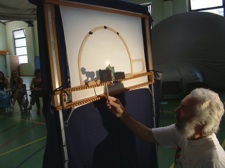GAM 2012 Blog
|
April 23 By Lara Albanese |
Back to the GAM Blog |  |
| In Touch with the Sky A meadow, the sun and—above it all—blue sky. Every night, stars shine upon every human being on Earth—and it does not matter if he or she is an adult or child, rich or poor, happy or sad, careful or not, or living in town or countryside |
||
 It is possible that children living in town have never seen a cow or a chick, and children from tropical countries have never touched the snow—but somewhere, somehow they have all seen the sky. And it does not matter if it is bright, crystal clear or cloudy—what matters is that all have seen it.
It is possible that children living in town have never seen a cow or a chick, and children from tropical countries have never touched the snow—but somewhere, somehow they have all seen the sky. And it does not matter if it is bright, crystal clear or cloudy—what matters is that all have seen it.
In relating to the sky, we are reduced to the use of just one sense: the sight. We can’t take advantage of any other kinds of perception because, apparently, the sky does not talk, does not have a scent, is not touchable. How, then can we be “in touch” with it—and why should we?
Perhaps most importantly, because the future world of our children will be closely bound up with the sky. The coming scientific and technological progresses will surely take them to travel through the galaxies or walk on faraway planets—as the Italian writer and pedagogue Gianni Rodari foresaw and described in his books:
“Dear children, ... I wrote, as it should be, many space and astronautical rhymes, since it’s going to be you who will who will walk across the stars: some of you will be spacecraft admirals, others will be radio-telegraphers on board. By that time, I will be very old and I will feel satisfied by sitting on a bench in a garden and looking up at you from the Earth.”
--Gianni Rodari, introduction to “Filastrocche in cielo e in terra”
Learning-Places for Children By the age of two, children are already aware of the sky. They know that the sun shines in it. They are amazed when they can see the Moon before it gets dark . They formulate hypothesis and remarks with great ability, and they come back to check if various phenomena occur regularly or if they change with the passing of time. The observation of the sky requires, more than any other scientific research, a great deal of time and patience. For this reason, it should become part of one’s daily routine. It is essential to create situations and suitable conditions where this type of observation can occur.
By the age of two, children are already aware of the sky. They know that the sun shines in it. They are amazed when they can see the Moon before it gets dark . They formulate hypothesis and remarks with great ability, and they come back to check if various phenomena occur regularly or if they change with the passing of time. The observation of the sky requires, more than any other scientific research, a great deal of time and patience. For this reason, it should become part of one’s daily routine. It is essential to create situations and suitable conditions where this type of observation can occur.
A planetarium dome offers an excellent venue for training, and it can be easily set up in any school. Projecting the stars on the dome can help recreate and manipulate what is observed in the actual sky. The curved structure of the dome, together with a central source of light, stimulates imagination—and it also recalls the atmosphere of the caves with their crackling fires where our ancestors told stories and no doubt projected shadows on the wall to animate these tales.
Inside the dome, imagination is kindled. By connecting the projected stars, the children create imaginary outlines. They can explain what led them to decide for one constellation's name or another, bringing stories to life. Here, science and fantasy walk side by side.
The Multicultural Dome The sky and its democratic principles associate people all over the world. The project “The Skies of the World”, realized by the Arcetri Astrophysical Observatory (Florence) and the Googol Association (Parma), was inspired by this idea.
The sky and its democratic principles associate people all over the world. The project “The Skies of the World”, realized by the Arcetri Astrophysical Observatory (Florence) and the Googol Association (Parma), was inspired by this idea.
The project’s “journey” toward awareness begins with the arrival of the portable dome. Here’s a snapshot of how it works:
“Children! Shall we go for a trip? What about going to China? You know, it would be too long to get there walking, and even by plane it would be an exhausting trip. But luckily, inside this dome we can move very fast. Are you ready? Here we are—in China.”
Suddenly the familiar Greek and Roman constellations disappear, and a new sky appears, populated by unknown constellations: a Chinese General, an emperor and an empress, a princess or an oxen's guardian—just where, a moment before, they had seen Orion, the Little Bear, the Eagle and the Lyre.
This way of changing the constellations is an easy switch for the planetarium’s operator (consisting of simply changing the projecting cylinder) and it can strongly influence people's perspective and point of view.
Inside the planetarium, among the myths represented and the projection of starry sky, time flies. Children begin to understand where and what stars are. They leave with a lot of questions and thoughts they may share with each others or address to an astronomer—who is “accidentally” waiting for them just outside.
|
|
Lara Albanese is a physicist, writer, educator, and researcher at the Arcetri Astrophysical Observatory (Florence, Italy). |








